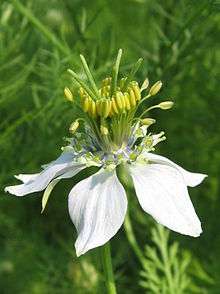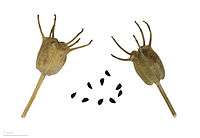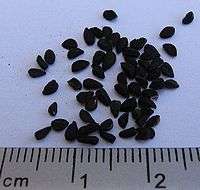Nigella sativa
Nigella sativa (black caraway, also known as black cumin, nigella, kalojeera, and kalonji)[2][3][4] is an annual flowering plant in the family Ranunculaceae, native to the Indian Subcontinent and West Asia.
| Nigella sativa | |
|---|---|
 | |
| Scientific classification | |
| Kingdom: | Plantae |
| Clade: | Tracheophytes |
| Clade: | Angiosperms |
| Clade: | Eudicots |
| Order: | Ranunculales |
| Family: | Ranunculaceae |
| Genus: | Nigella |
| Species: | N. sativa |
| Binomial name | |
| Nigella sativa | |
| Synonyms[1] | |
| |
N. sativa grows to 20–30 cm (7.9–11.8 in) tall, with finely divided, linear (but not thread-like) leaves. The flowers are delicate, and usually colored pale blue and white, with five to ten petals.
The fruit is a large and inflated capsule composed of three to seven united follicles, each containing numerous seeds which are used as spice, sometimes as a replacement for black cumin (Bunium bulbocastanum).
Etymology
The genus name Nigella is a diminutive of the Latin niger (black), referring to the seeds.[5]
In English, N. sativa and its seed are variously called black caraway, black seed, black cumin, fennel flower, nigella, nutmeg flower, Roman coriander,[3] and kalonji (from Hindustani).[6]
Blackseed and black caraway may also refer to Bunium persicum.[7]
Description
 Nigella sativa
Nigella sativa Seed
Seed N. sativa seeds
N. sativa seeds
Culinary uses
The seeds of N. sativa are used as a spice in Indian and Middle Eastern cuisines, and also in Polish cuisine. The black seeds taste like a combination of onions, black pepper, and oregano. They have a pungent, bitter taste and smell.[6] In Palestine the seeds are ground to make bitter qizha paste.[8]
The dry-roasted seeds flavor curries, vegetables, and pulses. They can be used as a seasoning in recipes with pod fruit, vegetables, salads, and poultry. In some cultures, the black seeds are used to flavor bread products, and are used as part of the spice mixture panch phoron (meaning a mixture of five spices) and alone in many recipes in Bengali cuisine and most recognizably in naan.[9] Nigella is also used in Armenian string cheese, a braided string cheese called majdouleh or majdouli in the Middle East.
History
Archaeological evidence about the earliest cultivation of N. sativa is unrecorded, but N. sativa seeds were found in several sites from ancient Egypt, including Tutankhamun's tomb.[10] Seeds were found in a Hittite flask in Turkey from the second millennium BCE.[11]
N. sativa may have been used as a condiment of the Old World to flavor food.[10] The Persian physician Avicenna in his Canon of Medicine described N. sativa as a treatment for dyspnea.[12] N. sativa was used in the Middle East as a traditional medicine.[13]
Chemistry
N. sativa oil contains linoleic acid, oleic acid, palmitic acid, and trans-anethole, and other minor constituents.[6] Aromatics include thymoquinone, dihydrothymoquinone, p-cymene, carvacrol, α-thujene, thymol, α-pinene, β-pinene and trans-anethole. Oils are 32% to 40% of the total composition of N. sativa seeds.[14] The seeds also contain thymoquinone.[14]
Research
One meta-analysis of clinical trials found weak evidence that N. sativa has a short-term benefit on lowering systolic and diastolic blood pressure, with limited evidence that various extracts of black seed can reduce triglycerides and LDL and total cholesterol, while raising HDL cholesterol.[15]
References
- "The Plant List: A Working List of All Plant Species".
- "BSBI List 2007". Botanical Society of Britain and Ireland. Archived from the original (xls) on 2015-01-25. Retrieved 2014-10-17.
- "Nigella sativa". Germplasm Resources Information Network (GRIN). Agricultural Research Service (ARS), United States Department of Agriculture (USDA). Retrieved 2017-12-11.
- Heiss, Andreas (December 2005). "The oldest evidence of Nigella damascena L. (Ranunculaceae) and its possible introduction to central Europe". Vegetation History and Archaeobotany. 14 (4): 562–570. CiteSeerX 10.1.1.156.85. doi:10.1007/s00334-005-0060-4. JSTOR 23419312.
- Hyam, R. & Pankhurst, R.J. (1995). Plants and their names : a concise dictionary. Oxford: Oxford University Press. ISBN 978-0-19-866189-4. p. 341.
- Bharat B Aggarwal (2009). Molecular Targets and Therapeutic Uses of Spices. Google Books. p. 259. ISBN 978-981-4468-95-4. Retrieved 4 January 2015.
- Bunium persicum - (Boiss.) B.Fedtsch. Common Name Black Caraway
- Berger, Miriam. "Is the world ready for this Palestinian dish?". www.bbc.com. Retrieved 2019-03-28.
- Bramen L (16 February 2011). "Nigella Seeds: What the Heck Do I Do with Those?". smithsonian.com. The Smithsonian Online. Retrieved 4 January 2015.
- Zohary, Daniel; Hopf, Maria; Weiss, Ehud (2012). Domestication of Plants in the Old World: The Origin and Spread of Domesticated Plants in Southwest Asia, Europe, and the Mediterranean Basin (Fourth ed.). Oxford: University Press. p. 206. ISBN 9780199549061.
- Saliha B, Sipahib T, Oybak Dönmez, E (2009). "Ancient nigella seeds from Boyalı Höyük in north-central Turkey". Journal of Ethnopharmacology. 124 (3): 416–20. doi:10.1016/j.jep.2009.05.039. PMID 19505557.CS1 maint: multiple names: authors list (link)
- Avicenna (1999). Canon of Medicine. Chicago: Kazi Publications.
- Hassanien, Minar M. M.; Abdel-Razek, Adel G.; Rudzińska, Magdalena; Siger, Aleksander; Ratusz, Katarzyna; Przybylski, Roman (15 July 2014). "Phytochemical contents and oxidative stability of oils from non-traditional sources". European Journal of Lipid Science and Technology. 116 (11): 1563–1571. doi:10.1002/ejlt.201300475. ISSN 1438-7697.
- Gharby S, Harhar H, Guillaume D, Roudani A, Boulbaroud S, Ibrahimi M, Ahmad M, Sultana S, BenHaddah T, Chafchaouni-Moussaouii I, Charroufa Z (2015). "Chemical investigation of Nigella sativa L. seed oil". Journal of the Saudi Society of Agricultural Sciences. 14 (2): 172–177. doi:10.1016/j.jssas.2013.12.001.
- Sahebkar A, Soranna D, Liu X, et al. (2016). "A systematic review and meta-analysis of randomized controlled trials investigating the effects of supplementation with Nigella sativa (black seed) on blood pressure". Journal of Hypertension. 34 (11): 2127–35. doi:10.1097/HJH.0000000000001049. PMID 27512971.